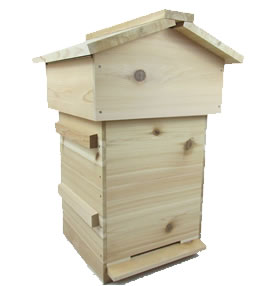How Does a Beehive Work? Understanding the Inner Workings of Bee Colonies
A beehive is a marvel of nature's engineering, serving as the central hub where honeybees carry out essential activities vital for colony survival and growth. Understanding how a beehive works requires insight into the intricate social organization, behaviors, and functions of honeybee colonies.
Basic Components of a Beehive
A typical beehive consists of several components, each serving specific functions:
- Hive Bodies: These are the main sections of the hive where bees live and work. They contain frames where bees build honeycomb and store food.
- Frames: Frames are removable trays that hold honeycomb. They provide structure and support for the comb and make it easier for beekeepers to inspect the hive.
- Foundation: Foundation is a thin sheet of beeswax or plastic that serves as a base for bees to build honeycomb.
- Brood Chamber: This is where the queen bee lays eggs, and young bees (larvae and pupae) develop. It's typically located in the lower portion of the hive.
- Super: Supers are additional hive bodies added above the brood chamber for storing surplus honey.
- Entrance: The hive entrance allows bees to come and go from the hive. It's also a critical point for ventilation and defense.
- Inner Cover and Outer Cover: These covers help regulate temperature and humidity inside the hive and protect it from the elements.
Functions of a Beehive
A beehive serves several essential functions that contribute to colony survival and productivity:
- Brood Rearing: The queen bee lays eggs in the brood chamber, where they hatch into larvae and develop into adult bees. The brood chamber provides a protected environment for young bees to grow and develop.
- Food Storage: Bees store honey, pollen, and bee bread (a mixture of pollen and honey) in the hive for nourishment. These food stores sustain the colony during periods of scarcity and provide energy for foraging bees.
- Temperature Regulation: Bees regulate the temperature inside the hive by fanning their wings to circulate air and clustering together to conserve heat. The hive's design and insulation help maintain optimal temperature and humidity levels for brood rearing and honey storage.
- Communication: Bees communicate with each other through a complex system of pheromones, dances, and vibrations. These signals convey information about food sources, hive location, and potential threats, enabling coordinated foraging and defense.
- Defense: Bees defend the hive against predators, parasites, and intruders using various strategies, including stinging, mobbing, and scent marking. Guard bees stationed at the hive entrance monitor incoming and outgoing bees and repel intruders.
- Honey Production: Honeybees produce honey by collecting nectar from flowers, converting it into honey inside their bodies, and depositing it into honeycomb cells. The bees cap the cells with beeswax to preserve the honey for long-term storage.
Conclusion
In conclusion, a beehive is a complex and highly organized structure that serves as the central hub for honeybee colonies. By understanding the inner workings of a beehive and the functions of its various components, beekeepers can better support colony health and productivity.
From brood rearing and food storage to temperature regulation and communication, every aspect of hive activity is essential for colony survival and success. By providing a suitable environment and proper care, beekeepers can help honeybee colonies thrive and contribute to the pollination of plants and the production of honey.



